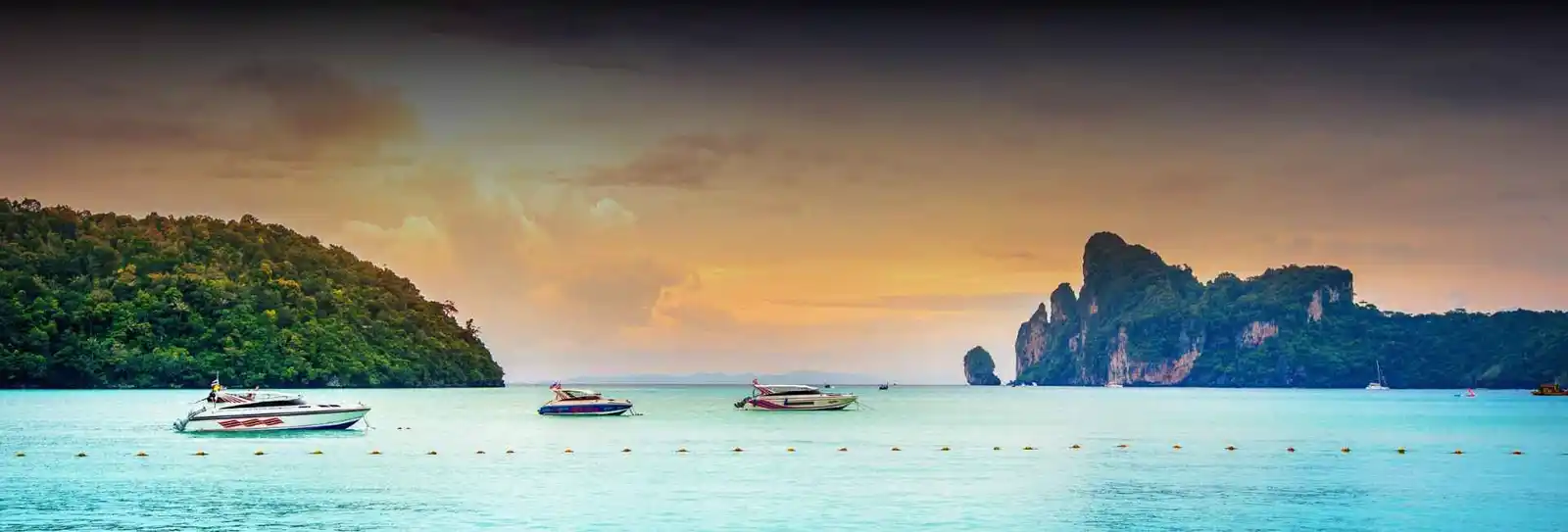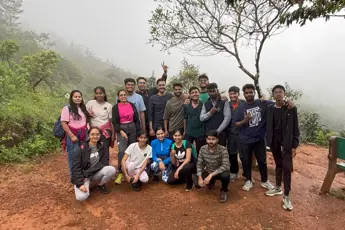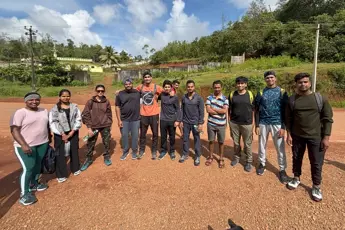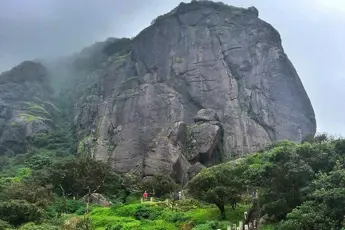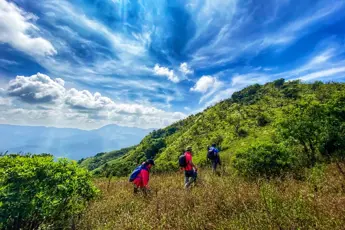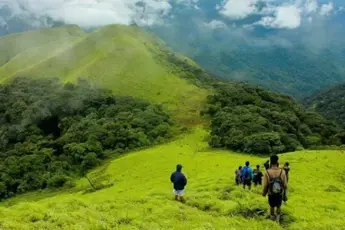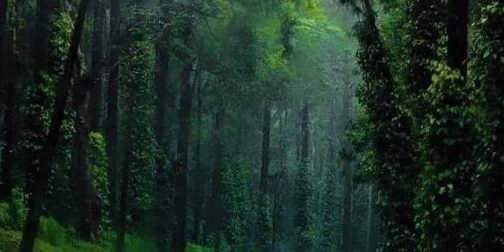
1. Abbey FallsAbbey Falls (also known as Abbi Falls) is one of the most breathtaking manifestations of Mother Nature that can be found in Coorg, Karnataka. The water from this waterfall, which is surrounded by coffee and spice plantations, simply cascades down a height of about 70 feet into the pool of water at the bottom, which is full of rocks, hence, the view is really captivating. Being situated amidst thick green pepper vines and cardamom estates, Abbey Falls is nature's perfect blend of tranquillity and calmness, making it a must-visit destination for relaxation and adventure lovers alike. The noisy fall of water hitting the pool with force, the chirping of birds, and the scent of the coffee plantation combine to create a unique sensory experience. The hanging bridge, which is near the waterfall, is an excellent spot for taking in the gorgeous view of the falls. The adventure lovers usually plan their visit together with trekking through the coffee plantations and the forest of that region. The distance from Madikeri town (around 8 km) makes it very convenient for tourists to get there, plus the beautiful drive adds to the charm. Particularly during the monsoon, when the water volume is maximum, Abbey Falls is quite stunning as it gives an amazing exhibition of nature's power.History of Abbey FallsJessey Falls was the original name of Abbey Falls long ago, which was the name of a British officer's daughter during colonial times. Later, a British settler called Mr Brown started a coffee plantation in the area and renamed the fall to Abbey. The fall then began receiving a huge number of visitors since both domestic and foreign tourists became a common sight there. The surroundings of Abbey Falls used to be an area of dense forest that was home to wild animals and tribal people. The falling remained intact despite coffee growing in Coorg in the 19th century, which caused most of the forest to be cut down and converted into plantations. The hanging bridge was constructed later to provide more ease to the visitors and give them a better sight of the water that was falling. Presently, Abbey Falls is the nature and culture symbol of Coorg that combines history, agriculture, ecology, and more. It reflects the area which has changed from deep forest to a fertile coffee-growing region but still, the natural wonder that continues to amaze and attract people is maintained.Nearby Places to Visit Abbey FallsRaja's Seat: Located in Madikeri, Raja's Seat is the garden with a lot of history and was used by Kodagu kings as a place to watch the sunset. This place has broad views of the Western Ghats and is well-maintained flower gardens.Madikeri Fort: This fort was built in the 17th century and it is a representation of Coorg's past. It also has a museum that houses various artifacts, ancient paintings, and cultural exhibits.Omkareshwara Temple: Omkareshwara Temple, a mix of Islamic and Gothic architecture and a temple dedicated to Lord Shiva, is a spiritually significant place near Abbey Falls.Mandalpatti: A gorgeous viewpoint is extremely popular for the hills that look like waves, the clouds that cover the place, and the perfect trekking trails. The distance of about 20 km from Abbey Falls.Best Time to Visit Abbey FallsSummer (March–May): The weather is great here, and it is perfect for sightseeing. However, the flow of the waterfall can only be moderate.Monsoon (June–September): This season is the best if you want to see Abbey Falls at its best. The water flow is heavy, and the green is lush. But if you are a trekker, make sure you look out for slippery paths.Winter (October–February): The cold and foggy atmosphere is good for photography, plantation walks, and visiting the nearby places.How to Reach Abbey FallsBy Airport: The nearest airport to Abbey Falls is Mangalore International Airport, which is approximately 150 km away. From there, you can take a taxi or a bus to Coorg.By Train: The nearest train stations are Mysore, which is 120 km, and Mangalore, which is 135 km. Both have good connectivity with the major cities of India. A cab or a bus can be taken to Madikeri from either of these stations.By Road: Madikeri town is only 8 km away from Abbey Falls. Apart from regular KSRTC buses, people can also travel in their private taxis or by their own cars from Bengaluru (250 km) and Mysuru (120 km). Hills, plantations, and forests can be seen while driving.2. Raja's SeatRaja's Seat Coorg, also known as the "Seat of the Kings," is located in the centre of Madikeri town; it is one of the area's famous places to visit. It was, in fact, a breathtaking garden with a view of the valley that could let the viewer have a panoramic view of the fog-covered Western Ghats, their colourful coffee plantations, the mountains, and the valley. The kings of Kodagu were the ones who gave the name to this place, as they were the ones who used to come here for peace, meditation, and watch the sunset beside the queen. At present, it has been turned into a decorated park with vibrant seasonal flowers, nicely paved walkways, and musical fountains, along which it has become a local place of attraction for nature lovers and families. The view at Raja's Seat is really heavenly in the early morning and at sunset when the sun's rays impart a magical aura over the mountains. Apart from being one of the top tourist destinations, it is also a rare and tranquil dwelling that exudes the magnificence of nature and the royal majesty of Coorg.History of Raja's SeatRaja's Seat has been a very important landmark in history and was the favourite place for the Kodagu kings to go for a holiday. The kings of Coorg would never miss a chance of bringing their queens to this scenic spot to enjoy the sunset behind the Western Ghats. It was the place where the royal family could come and relax, play their love, and also meditate at the same time. The term "Raja's Seat" means "Seat of the King," with no doubt, stressing the importance the place had in the king's daily life. Initially, it was a spot denoted by a very simple stone structure that was said to be the exact location where the kings sat, and gardens and trees that were quite old and large surrounded the place. The location was made very nice with time, and today, besides beautiful parks, it also has a musical fountain that attracts visitors during the night-time. Raja's Seat is also a representation of beautiful views, and it also tells the story of the kings living in peace and Coorg's prosperous past. It is an emblem that is the association between the monarchs of Kodagu and the various natural sceneries of their empire. Today, visitors to Raja's Seat can experience the tranquillity and spectacle that the royals once had, thus giving it historical significance, the geography of Coorg, and, over time, a natural landmark conserved.Nearby Places to Visit Raja's SeatMadikeri Fort: Fort Madikeri is a 17th-century historic fort that depicts the story of Coorg through the museum, chapel, and lovely architecture.Omkareshwara Temple: An amazing religious building of 1820, consisting of a unique mixture of Gothic and Islamic architectural styles which is dedicated to Shiva.Abbey Falls: Just 8 km away from Madikeri, Abbey Falls is a picturesque waterfall that is surrounded by coffee and spice plantations.Mandalpatti: A phenomenal point of view, giving the most stunning views and famous for trekking and jeep tours.Best Time to Visit Raja's SeatSummer (March-May): Extremely hot but still lovely and good for both morning and evening visits.Monsoon (June-September): Very green and dewy environs, happily outdoor activities can be limited because of the rain.Winter (October-February): Cold and foggy period, excellent for sightseeing and sunset watching.How to Reach Raja's SeatBy Airport: The airport most suitable for reaching Raja's Seat is Mangalore International Airport which is about 150 km away. A taxi or bus can get you to Madikeri, which will take a long time but will be very easy.By Train: The closest railway stations are Mysore, which is 120 km, and Mangalore, which is 135 km. Both of them are accessible from big cities. From there, you can take a cab or a bus to Coorg.By Road: There is no doubt that reaching Raja's Seat by car or bus is more convenient and easier, as the place is located in the middle of Madikeri town. You can take the scenic ride on the regular KSRTC buses, private taxis, and self-drive cars from Bengaluru (250 km) and Mysuru (120 km) and enjoy the peaceful trip.3. Dubare Elephant CampSet alongside the River Cauvery in Coorg, Karnataka, Dubare Elephant Camp, one of the most spectacular and captivating wildlife tours in the southern part of India, is home to the Asiatic elephants in great numbers. The camp, which is a project by the Forest Department of Karnataka and Jungle Lodges and Resorts, serves as a training centre where people can see the elephants up close and learn their behaviour, nature, and history. The uniqueness that the Dubare offers is the way it makes the visitors get in touch with the elephants as they can feed them, give them a bath in the river and get an insight into their training methods. Hence, it is a perfect place to go for families, wildlife lovers, and nature enthusiasts. The absolute harmony of the camp with the surrounding dense forest and the flowing Cauvery truly nature's way of combining adventure and peace is what makes the camp stand out. Lessons of elephant interaction aside, tourists can also participate in rafting on the river, trekking, and bird watching. With its captivating chances and natural beauty, the Dubare Elephant Camp is not just another tourist place, but a people’s conservation and eco-tourism journey.History of Dubare Elephant CampIn the past, Dubare was an area with a great ecological and cultural history related to elephants in Karnataka. The camp was the first time as a training ground for the wild elephants used in the Mysore Dussehra celebrations. Elephants that were taken from the forest were driven here for taming, training, and making them suitable for the ritual procession and the forest activities. The camp’s concerned and expert mahouts had families that had worked with elephants for ages, so they passed down the method of caring for and training the animals. Gradually, with the ban on capturing wild elephants, the motive of Dubare has changed from training to conservation and tourism. At present, the camp is a centre of elephant refuge for those who have been partners in logging or other forest-related work. It is also a place where people are taught about the ecology of the elephant and why it is necessary to protect such a noble creature. Through becoming a conservation-based eco-tourism destination, Dubare Elephant Camp stays on to be a vehicle for saving traditions while also creating awareness about wildlife. It comes as a living history of the human-animal interaction in Karnataka, yet at the same time it is firmly anchored to the present by modern conservation endeavours.Nearby Places to Visit Dubare Elephant CampNisargadhama: An adorable river island with bamboo groves, a hanging bridge, and a deer park, which is formed by the River Cauvery.Bylakuppe: A Tibetan community established within India, and being one of the most significant, extensively it covers and typifies the Tibetan monasteries such as Namdroling with its breathtaking architecture and colourful culture.Abbey Falls: A pretty waterfall with coffee plantations all around it, located at a distance of approximately 30 km from Dubare.Raja’s Seat: A charming garden located in Madikeri, from where one can watch the valleys and sunsets, at a distance of 29 km.Best Time to Visit Dubare Elephant CampSummer (March–May): Nice and moderate, suitable for outdoor activities and elephant interactions.Monsoon (June–September): The forest gets bright and green; however, the heavy rains can make movement difficult. Good for those who like to see the beauty of the monsoon.Winter (October–February): The most attractive period with cold weather, going around the camp, doing elephant activities and visiting the nearby places will be great.How to Reach Dubare Elephant CampBy Airport: Mangalore International Airport (about 160 km) is the closest airport. There is also Mysore Airport (100 km away) that is nearer but has limited connectivity.By Train: Mysore Railway Station (100 km) is the nearest big rail link that is well-connected to Bengaluru and various other cities. From Mysore, one can board a taxi or bus to reach Dubare.By Road: By road, it is very convenient to go to Dubare. The distance from Madikeri is approximately 30 km, and from Bengaluru is about 240 km. There are different transportation options such as KSRTC buses, private cabs, and self-drive vehicles, which offer you to make a journey attractive through the coffee plantations and forest landscapes.4. Talacauvery & BhagamandalaTalacauvery, the sacred origin of River Cauvery in the Brahmagiri Hills of Coorg, Karnataka, is one of the most holy rivers of South India. At around 1,276 meters above sea level, Talacauvery is a beautiful natural place with serene spiritual vibes. A small tank has been built at the source of the river from where it is said that the river comes and goes underground and hence it is a re-route at Bhagamandala. A large number of visitors have thus flocked the holy place to take a dip in the tank and offer their prayers. The temple of Talacauvery, the shrine of Goddess Cauvery is the main center of attraction to thousands of devotees especially during the Tula Sankramana festival in October when the origin of the river is represented by the abrupt upward flow of water from the spring. Bhagamandala is another sacred place just 8 km downhill from Talacauvery, where the River Cauvery joins the Kanike and Sujyoti rivers to form the holy “Triveni Sangam.” It is believed that bathing here gets you rid of all the sins. Bhagandeshwara Temple constructed in Kerala-style architecture and dedicated to Lord Shiva is the major point of interest. Alone or together with Talacauvery, Bhagamandala is a perfect combo of spirituality, culture, and nature's beauty, which are two of the best places you should visit while you are in Coorg.History of Talacauvery & BhagamandalaThe history of Talacauvery and Bhagamandala is based on Hindu mythology and the spiritual-sacred legacy of the Coorg region, deeply. According to a myth, the river Cauvery is a goddess who assumed the human form and later changed into the river to bless the people of South India. Sage Agastya is said to have performed great austerity here, thereby making it more sacred. For many centuries, the temple of Talacauvery has been the centre of worship, and the kings of Kodagu, as well as the devotees, have always been involved in its maintenance and renovation. Indeed, we can find a history of a similar kind in Bhagamandala. It is said that Sage Bhagandeshwara, a devotee of Lord Shiva who performed austerity by the waters of the Cauvery, founded the Bhagandeshwara temple. The temple had the support of the kings of Kodagu in the beginning and was later taken care of by the Mysore rulers. From the times of old the Triveni Sangam has been considered as the sacred confluence and a pilgrimage destination that has attracted saints, sages, and devotees. Talacauvery and Bhagamandala are both the very face of devotion and culture and are not just religious monuments but also places that draw a lot of visitors due to their breathtaking natural surroundings and great antiquity i.e. they have survived through time.Nearby Places to Visit Talacauvery & BhagamandalaBrahmagiri Hill Trek: A breathtaking trek providing the spectacular views of the Western Ghats, forests, and wildlife.Raja’s Seat: A charming garden in Madikeri, famous for its views of sunrise and sunset.Abbey Falls: A beautiful waterfall located between the coffee plantations, about 35 km from Talacauvery.Dubare Elephant Camp: A wildlife camp on the banks of the Cauvery, where tourists can have close interaction with the elephants, is located about 60 km away that is which you can reach by car, train or bus.Best Time to Visit Talacauvery & BhagamandalaSummer (March–May): Enjoyable weather, perfect for temple visits and sightseeing.Monsoon (June–September): The heavy downpours make the scenery very green, but travelling can be difficult. Best for nature lovers.Winter (October–February): The most favourite season with cool weather, great skies, and celebrations like the Tula Sankramana Festival at Talacauvery.How to Reach Talacauvery & BhagamandalaBy Airport: Mangalore International Airport (about 180 km away) is the closest airport, and Mysore Airport (around 130 km) is the second nearest.By Train: Mysore (130 km) and Mangalore (170 km) are the two nearest railway stations. Both are well-connected with Bengaluru and other cities.By Road: Talacauvery and Bhagamandala are about 40 km from Madikeri. The buses and taxis that run regularly from different places, viz. Madikeri, Mysuru (150 km), and Bengaluru (270 km) can be used for the trip. It is a very beautiful route as it goes through the coffee plantations, forest and the hills.5. Cauvery NisargadhamaCauvery Nisargadhama is an amazing river island that is located about 28 km from Madikeri and 2 km from Kushalnagar in Coorg, Karnataka. The 64-acre island that was formed due to the River Cauvery is still the spot where people come to have a look at and experience nature, as it is an island that is covered with bamboo, which is also part of a forest that is surrounded by sandalwood and teak trees. People can get to the island through a hanging rope bridge, which alone is a beautiful access. There they can have a calm nature walk along with the use of a boat, elephant rides, seeing deer, and walking through the forest path as main activities. Nisargadhama is also installed with a children's play area, tree-top bamboo cottages for camping, and picnic spots, in this way being an excellent family holiday. The calm riverbanks and tree-lined paths create a very soothing atmosphere, which is really nice for those who are looking for an escape from the hustle and bustle of city life. Because of its unspoiled beauty and eco-friendly nature, Cauvery Nisargadhama is one of the best-of-the-best places in Coorg.History of Cauvery NisargadhamaThe Karnataka Forest Department had made Cauvery Nisargadhama the chief idea of the eco-tourism in Coorg. Though the River Cauvery had always been the centre of the region's culture and spirituality, the change of Nisargadhama into a tourist destination is only a new trend. The implicit motive was letting nature’s guests experience a refuge in nature for themselves and at the same time, keep them informed about conservation and sustainable tourism. In due course, the island has turned into a must-go place for tourists visiting Kushalnagar and the Tibetan settlements around. Besides, the place has also been designed to protect the area's flora and fauna by permitting recreation like boating and elephant rides. Now it is referred to as a perfect coming together of nature's beauty with environmentally friendly amusement activities, thus an excellent example of tourism and conservation working hand in hand.Nearby Places to Visit Cauvery NisargadhamaBylakuppe Tibetan Settlement: It is situated 6 km away and is one of the major Tibetan settlements in India. It is famous for Namdroling Monastery and the gold Buddha statues.Dubare Elephant Camp: It is located around 15 km from Nisargadhama. The main reason for the establishment of the camp is to allow visitors to have close encounters with the elephants in the wild.Harangi Dam: It is a beautiful dam that is situated about 9 km from there and is good for making picnic plans or watching the sunset.Abbey Falls: Abbey Falls is 35 km away from Kushalnagar and is the perfect place to visit if you want to see the impressive waterfall amid coffee plantations.Best Time to Visit Cauvery NisargadhamaSummer (March–May): The weather is great for outdoor activities and picnics although the sun can be quite hot in the afternoon.Monsoon (June–September): The river is at its maximum, the island becomes vibrant, and the view is at its most beautiful.Winter (October–February): The clean and refreshing atmosphere makes it the high season when visitors including families and couples come to pay their visits.How to Reach Cauvery NisargadhamaBy Airport: The nearest airport is Mangalore International Airport (about 160 km). Mysore Airport (around 95 km), which is closer but has limited flights, is another alternative.By Train: Mysore Railway Station (95 km) is the nearest major railhead, and it has good connections to Bengaluru, Chennai, and other cities.By Road: There is a good road network to Cauvery Nisargadhama. It is 2 km from Kushalnagar and 240 km from Bengaluru. The trip can be made calm and delightful with the presence of KSRTC buses, private cabs, and self-drive cars as one passes through stunning coffee estates and forests.6. Omkareshwara TempleOmkareshwara Temple is a wonder in Coorg, Madikeri town, Karnataka; the temple is a unique mixture of outstanding architectural and spiritual landmarks that are not found anywhere else in the world. The temple was built by King Lingarajendra II in 1820 and is the place of worship of Lord Shiva. The outstanding thing about this temple is the perfect fusion of Islamic, Gothic, and traditional Hindu architectural styles, which is rare in any other part of South India. The temple gets its eccentric attraction from the fact that the main dome, the spires of the four corners, and a huge tank for water are all there. According to popular belief, the Omkareshwara temple is identified as a Shiva Linga that was transported from Kashi (Varanasi) and thus, it is a very famous temple that a large number of thechoir of devotees come to worship. Omkareshwara temple is with its historical and religious importance and calm atmosphere an absolute must for pilgrims and tourists visiting Madikeri area.History of Omkareshwara TempleThe temple legend is mostly attributable to the marriage between the royal family myths and the exaggeration of the folklore of the area. It is said that the temple was constructed by King Lingarajendra II in 1820 as a kind of self-punishment. The plot is that the king had a Brahmin murdered without any reason, and the Brahmins, following a chain of unfortunate events, organised a protest. To seek forgiveness and also to get it, the king built the Omkareshwara Temple and installed a Shiva Linga, which was directly brought from the holy city of Kashi for this event. The temple's architecture represents the king's peculiar character as it combines Islamic-style domes and Gothic-style arches with Hindu religious rituals seamlessly, without any conflict. On the temple's history, it is deeply marked by the presence not only as a place to worship but also as a cultural icon of Coorg, which reflects the intermingling of various influences; thus, it still functions as a religious centre for the devotees, as it not only keeps the events and celebrations of the temple but also draws tourists and visitors.Nearby Places to Visit Omkareshwara TempleRaja's Seat: One of the scenic gardens and lookout points of Madikeri, from where one can relax, watch the sunsets, and also enjoy the breathtaking views of the Western Ghats.Madikeri Fort: A 17th-century fort that tells the history of Kodagu and also features a museum along with some colonial-era buildings.Abbey Falls: A beautiful and rejuvenating retreat from mundane life, situated 8 km from Madikeri, and surrounded by coffee plantations.Dubare Elephant Camp: The camp is located 30 km away, and it lets visitors have close interactions with the elephants in their forest home by the riverbank.Best Time to Visit Omkareshwara TempleSummer (March–May): It gets hot, but the weather is still quite pleasant for temple visits and sightseeing of Madikeri's attractions.Monsoon (June–September): Due to the heavy showers, trees are full of dense green leaves. Visiting temples can be enjoyable, but one has to be very careful not to slip because of the slippery paths. A scenic season but a wet one.Winter (October–February): Cool weather, bright skies, and temple festivals make it a perfect time to come.How to Reach Omkareshwara TempleBy Airport: The nearest airport is Mangalore International Airport, about 160 km away. Another option is Mysore Airport (120 km), which, however, has limited flights.By Train: Mysore Railway Station (120 km) and Mangalore Railway Station (135 km) are the nearest railway stations, both are well-connected to Bengaluru and other cities. From there, one may avail buses or taxis.By Road: The temple is centrally located in Madikeri town, and local transport will take you there in no time. Buses operated by KSRTC, taxis owned by private individuals, as well as self-driven cars, are all good means for the trip from Bengaluru (260 km) and Mysuru (120 km).7. Madikeri Fort (Mercara Fort)One of the most celebrated monuments of Coorg, Karnataka besides telling the story of its heritage is Madikeri Fort or Mercara Fort. This architectural wonder that sprawls over a big area and speaks the rich heritage of the local people is very centrally located in Madikeri town. It was at first a mud fort built by Muddu Raja during the 17th century, but Tipu Sultan converted it into a granite fort in the late 18th century. There are also temples, palaces, and jails inside the fort. Visitors who are walking along the old fortifications, massive walls, and gates that breathe the history of the royal era of Coorg or wars, at the same time come across a museum that displays the relics, arms, and documents, among others, that depict the cultural and historical progression of Coorg. Whether it is the melding of military architecture with the colonial style, which makes the Madikeri Fort a wonder for history lovers, the photographers who are fascinated by the story of the Kodagu kingdom, or the people who are just curious about the past -History of Madikeri Fort (Mercara Fort)The history of the Madikeri Fort is an extensive account of the Kodagu Kings and the wars of South India that occurred in the 17th and 18th centuries. Besides renovating the fort that was built by Muddu Raja, Tipu Sultan also converted the fort into a granite one. To add on to reconstructing work, Tipu Sultan also put up high walls and arched gates, and as part of the fort’s defensive measures thickened the walls. After Tipu Sultan’s demise in 1799, it was the British Empire that assumed control over the fort and went on to mix colonial-style architectural designs with the existing fort through extensive alterations. As the fort has been the witness to such historical events as battles between local chieftains and the British invasion, it still holds the political history of Coorg. To be exact, it is a building that has been rescued from the past when the blending of native Kodagu architecture, the warlike mind of Tipu Sultan, and colonial influences by the British could be seen. The museum situated in the fort gives a history of Coorg through the artefacts exhibited, including weapons, inscriptions, and historical documents describing the history of the rulers of the area and their conflicts. Visiting Madikeri Fort is not only a historical tour but also a cultural festival when visitors are offered the opportunity to live the royal era of Coorg by going back in time.Nearby Places to Visit Madikeri Fort (Mercara Fort)Raja’s Seat: Raja’s Seat is a splendid garden at Madikeri that gives panoramic views of valleys and hilltops and is the most suitable place to catch the sunset.Omkareshwara Temple: It is a peculiar temple that fuses Gothic, Muslim, and Hindu architectural styles and is a place of worship for Lord Shiva.Abbey Falls: Abbey Falls is a beautiful waterfall that is 8 km from Madikeri and is enclosed by coffee plantations.Cauvery Nisargadhama: This is a river island that comes with bamboo groves, picnic spots, and is also a place for elephant rides and is located 28 km away.Best Time to Visit Madikeri Fort (Mercara Fort)Summer (March-May): The ambience is very close to being perfect, and it can bring out the best in a visit to the fort and Madikeri walk.Monsoon (June-September): Lush plants are around the fort, but strong rain can make walking risky.Winter (October-February): This is the most comfortable season with cold weather and is nice for sightseeing and photography.How to Reach Madikeri Fort (Mercara Fort)By Airport: The closest airport is Mangalore International Airport (about 160 km). Mysore Airport (120 km) with limited flights is another alternative.By Train: The nearest railheads are Mysore Railway Station (120 km) and Mangalore Railway Station (135 km). From there, you can hire a taxi or take a bus.By Road: The fort is located in the centre of Madikeri town, and you can reach there by local transport without any difficulty. Moreover, you can arrive in Madikeri from Bengaluru (260 km) or Mysuru (120 km) by a regular KSRTC bus, a private taxi, or your own car.8. Irupu (Iruppu) FallsIrupu Falls, also known as Iruppu Falls, is one of the most magnificent waterfalls in Karnataka situated in the Brahmagiri Range of Coorg district. This waterfall is a nature's marvel that gets tourists enchanted by its beauty when it drops approximately 170 feet from the dense forests and the towering Western Ghats around it. The water running is the Lakshmana Tirtha River, which is a river that originates from the Brahmagiri Hills. The stunning experience of the fall along with the calm environment and serene vibe is indeed a fun way to spend time with nature and take nice shots for photography lovers as well as taking the scenario of the place into consideration, it is the perfect stopover for the Adventurous walkers. The place also has fame for its tale and legends beside mythological significance as it happens to be connected to Ramayana an epic poem.History of Irupu (Iruppu) FallsThe historical background of Irupu Falls goes back to the times of Hinduism's mythical stories and the tradition of local people. Per the story, Lord Rama was led by Lakshmana to the Brahmagiri Hills to shoot an arrow to bring water for Sita when he was on exile which is basically the reason the river Lakshmana Tirtha and the Irupu Falls were born. This tale makes the waterfall a place of pilgrimage for the pious; a small shrine devoted to Lord Rama is also very close by. Very long ago, the place surrounding Irupu Falls was a thick forest that was home to the tribal people, the communities who adored the falls together with the neighboring hills. Therefore, with time, that spot was not only for the people living in the forests but also for the tourists because some forest routes and security measures were put in place for the protection of both the visitors and the nature. At present, once against people are attracted to Irupu Falls, a huge number of tourists and pilgrims come. Irupu Falls is a myth that dominates the cultural and ecological heritage of nature and legends coexist in the most harmonious manner in this way.Nearby Places to Visit Irupu (Iruppu) FallsRamakrishna Mission Ashram: The ashram is a spiritual centre that is located close by providing yoga and meditation sessions, amidst a calm, and tranquil environment.Nisargadhama: A river island near Kushalnagar, which is loved for its bamboo groves, hanging bridge, and family-friendly activities like boating, and deer-spotting.Brahmagiri Wildlife Sanctuary: The wildlife lovers’ paradise, this sanctuary is home not only to elephants and tigers but also various bird species.Tala Cauvery: The holy origin of the River Cauvery, located approximately 70 km from Irupu Falls, draws pilgrims as well as nature lovers.Best Time to Visit Irupu (Iruppu) FallsSummer (March–May): It is a good time for trekking and short visits when the water in the fall is moderate.Monsoon (June–September): At this time, the waterfall is at its maximum and the most impressive; however, paths can be slippery and thus caution is recommended.Winter (October–February): Typically cold and nice weather, best for sightseeing, taking photos, and enjoying the natural surroundings.How to Reach Irupu (Iruppu) FallsBy Airport: Mangalore International Airport (about 140 km away) is the nearest airport, with taxi and bus services operating to Coorg, making it a two-stage trip.By Train: The nearest train station is Mysore (about 110 km), from where the railways to Bengaluru and the other important cities are fairly well connected. From the station of Mysore, one can charter a cab or board a bus.By Road: One can reach Irupu Falls with either the Madikeri route (about 75 km) or the Kushalnagar route (around 65 km). KSRTC buses and privately operated taxis, along with self-drive cars are the most popular and convenient means of transportation for the journey. Moreover, this road has some coffee estates, forest, and hill views, making it more attractive.Why Book with escape2exploreWhen exploring the Coorg tour Package from Bangalore and beyond, escape2explore stands out as a trusted name in adventure and experiential travel. Here’s why hundreds of travellers choose us for their getaways:Trusted, Well-Reviewed Local Operator: escape2explore has gained the trust of thousands of content tourists all over India. With persistent positive feedback and an unblemished reputation for delivering quality experiences, we assure your experience to be hassle-free, memorable, and value-packed. Our insider local knowledge guarantees that you to always be in safe hands.Seasoned Guides: Our trips are led by friendly, trained, and professional guides who are passionate about the outdoors and your safety. Whether it's a beach trek, a cultural tour, or a spiritual walk through temples, our team knows the terrain, the stories, and how to make each moment count.Safe & Curated Itineraries: Your safety is our number one priority. Each of our tour packages is thoughtfully crafted with safety measures, researched accommodations, and easy travel arrangements. We take care of the details so you can have the experience hassle-free and worry-free.Unique Experience That You Won't Find Anywhere Else: With escape2explore, you discover more than the tourist attractions. We go off the beaten track with hidden beaches, unusual treks, offbeat cultural destinations, and true interactions. Whether camping out beneath the stars or exploring a hidden beach cove, we present to you the other side of Coorg that not many get to encounter.


